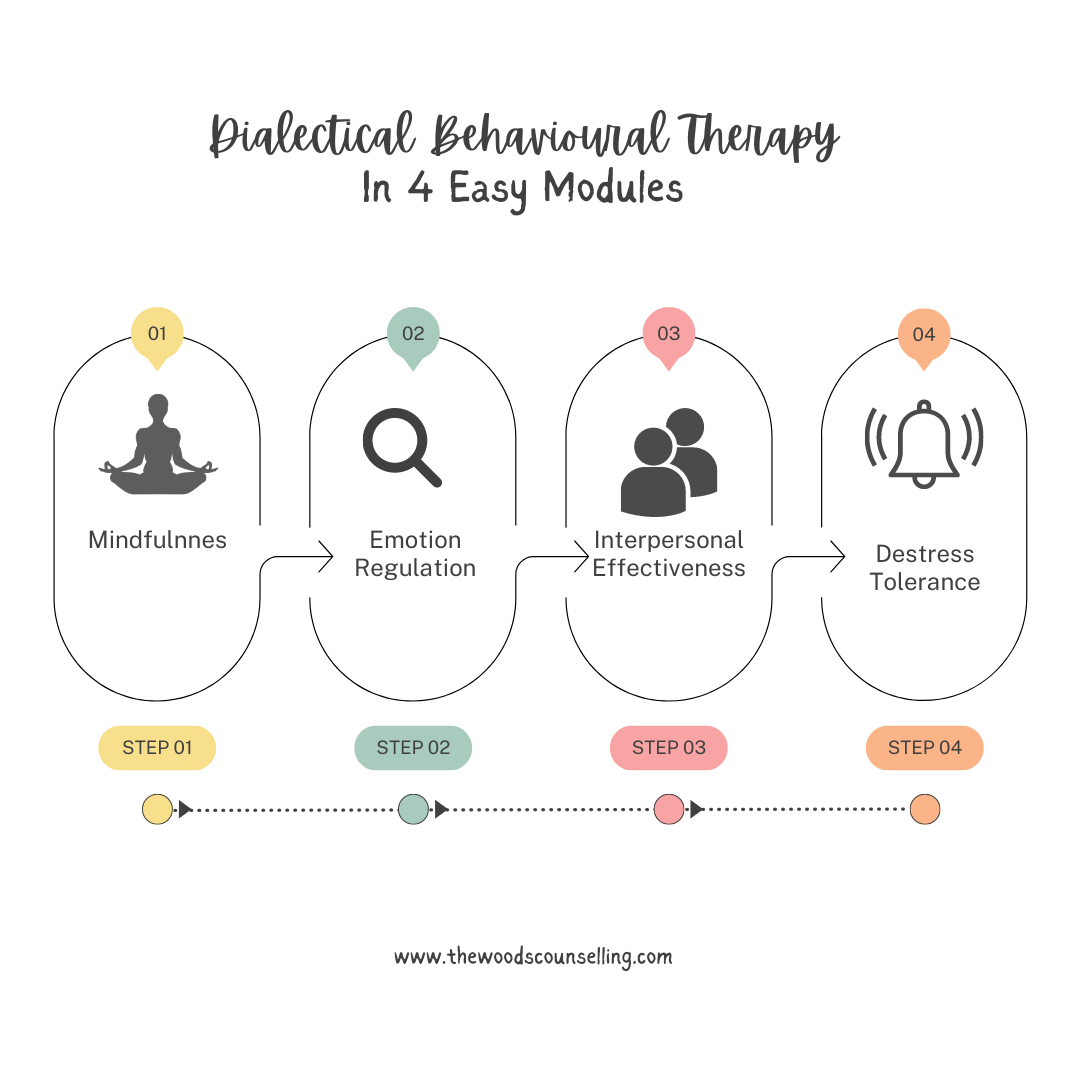
Welcome to The Woods Counselling
Better Health Blog
Here we offer insight on the best ways to approach trauma, and teach you the skills we’ve learned to handle chronic illness. And you’ll also find free counselling resources to put them into action.
search

Mindfulness Module
In Virtual Therapy we go over all the modules of DBT. And in the Mindfulness Module of DBT we focus on the practice of paying attention by focusing the mind (Linehan & Wilks, 2021). This helps clients to stay focused on one thing at a time. In the here and now.
Mindfulness Skills are central to DBT Skills as they are incorporated throughout all other modules. And there are three subsets of Mindfulness Skills that we go over,
1. The What skills are Characteristics of Mindfulness
2. The How skills Guide us on how to be mindful
3. Finding Wise Mind: is through teaching clients the dialectical balance of the Reasonable mind (rational/logical part), with the emotional mind which is the feelings and thoughts part.

How do You Use online therapy to go over DBT Modules?
In online therapy we go over the DBT four main skills modules: mindfulness, emotion regulation, distress tolerance, and interpersonal effectiveness. Through using new techniques like adding in slideshows, fun youtube videos and other technology to liven up the whole process.
"DBT has a modular structure, designed so that it's components can be dropped in and pulled out according to client needs. "(Norman-Nott et al., 2021). That means that these modules each can take a two-week timeframe to teach.

Basic Assumptions that therapist approach clients with in DBT
One of the core principles of dialectical behavior therapy (DBT) is the idea of basic assumptions. These are the beliefs that therapists hold about their clients and themselves when they engage in DBT.
The basic assumptions are:
The Basic Assumptions that therapist approach clients with when doing DBT is that:
1. all people are doing the best they can
2. That people want to improve
3. All people need to do better than they are, and try harder to be more motivated to change
4. People may not have caused all their problems but all people have to solve them anyway.
5. New behavior must be learned in all relevant contexts
6. All behaviors are caused
7. Figuring out and changing the cause of behavior is much more effective than trying to change by being judgmental and trying to blame others.
Want to learn more about virtual therapy and our online counselling services? Hit the button below!

What are the Goals of DBT
The big overarching goal of DBT is to help clients build lives that they experience as worth living. And using the life skills taught in DBT is a key factor in building that life. To do this DBT combines dialectical elements of both 1. Acceptance of reality and 2. Encouraging Change as we will review soon.
Though there are many dialectical assumptions in DBT. The main one is that clients are doing the best they can at any given moment in time. And also, that they must learn new behaviors in all relevant contexts. As skills don't always transfer between contexts.

What is DBT?
Our online therapist specializes in Virtual Dialectical Behavioral Therapy (dbt) which was originally developed by Marsha Linehan in 1993 to treat unremittent suicidal ideation and Borderline Personality Disorder (Meygoni & Ahadi, 2012). It is a subset of Cognitive Behavioral Therapy (cbt) and incorporates similar cognitive and behavioral strategies. In research studies, Linehan actively recruited the most severe, highly suicidal clients from their local areas and hospitals (Linehan et al., 1991). Through the development and teaching of this therapy style, there was a dramatic drop in depression levels and the majority returned to normal functioning.

What is an Attachment Style?
In relationship counselling we look at your attachment system. This is based on what happened growing up and your genetics. So, both nature and nurture combined to create how you unconsciously respond in relationship situations. This can have a big part to play in your therapy especially if your looking for: help with relationship issues, therapy for a breakup, therapist for abandonment issues, relationship anxiety counselling, etc.
The nurture part refers to both the environment and parenting styles you were raised with. Then, nature is based on how your genetic background plays a part. This means that your parent’s attachment styles can be passed down and be a factor in your likelihood towards each style.

Managing PTSD With Therapy
How Do You Start Virtual Therapy?
Picking A Therapist You Like And Feel Comfortable With.
Choosing a counsellor that fit's with you is important! This is because it will account for 30% of the therapeutic effect in your sessions. Also considering the therapist's qualifications. As one that has a master's in counselling has spent years studying psychology whereas others may not have. This is recommended the BC Association of Clinical Counselling. This means there will be an MA by their name. And lastly, it can be a good idea to choose one that specializes in trauma. This is for the same reason that you go to doctors that specialize in eyes, or ears. They may both understand how each part of the body works but the ear doctor works with ears everyday, and probably has extra education in that area.
2. Picking A Therapy Style That Lowers The Symptoms Of PTSD
Due to the large amount of research and evidence supporting CBT, it's strongly recommended as a first line treatment, over other variations of CBT or other therapy styles. The American Psychological Association has recommended this because it’s an approach that addresses all the symptoms through both thoughts and actions. This has been shown to have a strong effect on lowering symptoms in both acute stress disorder and post-traumatic stress disorder.

What can cause Trauma? and Why is Trauma effecting me so differently?
What can cause a trauma? Why am I reacting differently to a sexual assualt, MVA, hospital surgery, or other event? When a person is in this event and drops into freeze or shock, it’s often because they cannot fight or flee from the threat. This can cause part of the brain to go offline, they then cannot feel or process what is happening.

Healthcare, Mental Health, & Chronic Illnesses
What are the mental health and healthcare gaps or frequently asked questions I have noticed as a bc clinical counsellor?
there has been an increase in chronic illnesses. 2.lack of understanding of the intersectionality of chronic illness and mental health. This can be seen through the lack of mental health providers that treat chronic illnesses. 3. As well as a lack of doctors who refer to mental health support
This gap can be seen through the general understanding, of how mental health impacts chronic illnesses. And could be solved with more education on mental health in medical programs. As well as aided through the way we speak about mental health with patients that hold chronic illness diagnoses.

The Beginners Guide to Meditation
As we do this mindfulness lesson we are practicing mindfullness from the dialectical behavior therapy module that our virtual therapist teaches.
Topic: Mindfulness And Cognitive Distortions
The first step towards mindfulness is setting aside the time in your day to form this new habit. So, find a time that works for you, that may be in the morning or evening. Find a time that works for you and start with an easy three-minute breathing exercise. As, “When we pay attention to our breath, we are learning how to return to, and remain in, the present moment—to anchor ourselves in the here and now on purpose, without judgment.” (Staff et al., 2021).

A Grounding Exercise To Calm Your Anxious Thoughts
In the last breathing exercise it helped us focus on the present moment. Building on that mindfullness exercise we’re going to work on how we can not only be in the present moment, but also learn to ground ourselves when we start to feel overwhelmed with the uncertainties of life. This can be a big part of therapy styles like dialectical behavior therapy (dbt), (cbt) cognitive behavioral therapy, and Stress therapy. As we incorporate mindfulness into your day we hope you’ll see enjoy a little bit of a better moment from better therapy.


